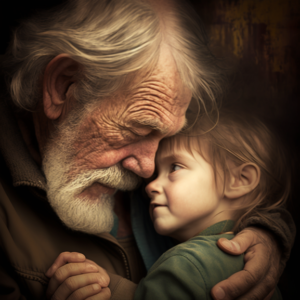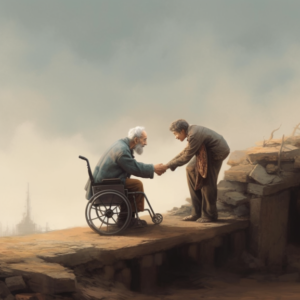Are you or a loved one experiencing increased anxiety as you age? Anxiety in older adults is more common than you might think. In fact, research shows that nearly 20% of seniors experience anxiety disorders. But don’t worry, we’re here to help!
Our blog will provide an insightful exploration of this often-overlooked issue, offering practical tips and resources to unmask anxiety in the elderly. Join us on this journey and discover how to support your mental health in your golden years.
Key Takeaways
- Anxiety disorders are more prevalent in older adults than commonly believed, with nearly 20% of seniors experiencing these conditions.
- Generalized anxiety disorder, panic disorder, phobias, and post-traumatic stress disorder are common types of anxiety disorders in the elderly.
- Symptoms to watch out for include sudden feelings of fear or terror, constant worry, trouble sleeping, isolation from social activities, and physical symptoms such as headaches or rapid heart rate.
Background on the prevalence of anxiety disorders in older adults
Anxiety disorders, long associated with younger adults, show a surprising prevalence in the older population. Millions of seniors across the globe grapple with various anxiety issues ranging from generalized anxiety disorder to panic attacks and phobias.
Studies have shown that about 15 percent of those over age 65 experience symptoms of an anxiety disorder that causes them distress and functional impairment.
Despite these figures, geriatric anxiety remains underrecognized and undertreated in many healthcare settings. Many older adults may not understand their symptoms or may view them as a natural part of aging or even signs of physical illness, leading to inaccurate diagnosis or no diagnosis at all.
As we strive towards better mental health for everyone, it becomes essential to uncover this issue afflicting our senior population.
Common Types and Symptoms of Anxiety Disorders in the Elderly
Anxiety disorders in older adults include generalized anxiety disorder, panic disorder, phobias, and post-traumatic stress disorder. Physical symptoms such as increased heart rate and sweating, along with psychological symptoms like excessive worry and fearfulness, are common signs to look out for.
Overview of generalized anxiety disorder, panic disorder, phobias, and post-traumatic stress disorder
Generalized Anxiety Disorder (GAD) in elderly adults often manifests as excessive worry about everyday life events. Panic disorder, another common form of anxiety, triggers sudden periods of intense fear known as panic attacks.
In contrast, phobias induce an intense irrational fear or aversion towards specific objects or situations. Finally, Post-Traumatic Stress Disorder (PTSD), typically associated with distressing events such as war or disaster exposure, can emerge even in late adulthood from past trauma.
These disorders all fall under the umbrella term ‘anxiety disorders’, each presenting unique challenges to older adults’ mental health.
Physical and psychological symptoms to look out for
Spotting anxiety disorders in the elderly begins with being aware of physical and psychological symptoms. Here are some signs to watch out for:
- Sudden and intense feelings of fear or terror
- Constant worry about future events or past experiences
- Trouble staying or falling asleep
- Increasing isolation from social activities
- Persistent feelings of sadness or hopelessness
- Unexplained physical aches such as headaches, stomach aches, muscle tension, and trembling
- Extreme sensitivity to health-related issues or heightened fear of death
- Rapid heart rate
- Difficulty concentrating or remembering things
- Restlessness and irritability
Factors Contributing to Late-Onset Anxiety in the Elderly
Late-onset anxiety in the elderly can be caused by changes in brain chemistry, the effects of aging on physical and mental health, as well as stressful life events.
Changes in brain chemistry
The function of the brain alters as we grow older, leading to changes in brain chemistry. These transformations can influence mood and cognition, potentially paving the way for anxiety disorders in elderly individuals.
In particular, altered levels of neurotransmitters – chemical messengers that transmit signals between nerve cells – may play a pivotal role. For instance, decreased serotonin levels have been linked with feelings of anxiety and depression.
Similarly, changes in gamma-aminobutyric acid (GABA), another neurotransmitter associated with mood regulation, could contribute to heightened anxiety symptoms among seniors. Understanding these chemical shifts is central to unmasking anxiety in the elderly population and developing effective treatment strategies.
Effects of aging on physical and mental health
As older adults age, they may experience various effects on their physical and mental health. These changes can include declining physical capabilities, such as decreased strength and mobility, as well as cognitive decline and memory issues.
Additionally, the aging process can contribute to an increased risk of developing mental health disorders, including anxiety. It is important to recognize how aging can impact both our bodies and minds in order to provide appropriate support and care for older adults.
Stressful life events
Stressful life events can contribute to the onset of anxiety in older adults. These events may include the loss of a loved one, retirement, financial difficulties, or health problems.
When faced with these challenges, older adults may experience increased worry and fear, leading to symptoms of anxiety disorders. It is important to recognize the impact that stress can have on mental health and provide support for coping with these difficult life circumstances.
By addressing stressful life events and providing appropriate resources and interventions, we can help alleviate anxiety symptoms in older adults and improve their overall well-being.
The Impact of Anxiety on Older Adults
Anxiety in older adults can have serious consequences, including an increased risk of cardiovascular disease and mortality, as well as a negative impact on quality of life. Discover the true extent of this overlooked issue and learn how it can be addressed for the well-being of our elders.
Read more to understand the impact anxiety has on older adults.
Increased risk of cardiovascular disease and mortality
Anxiety in older adults not only affects their mental health but also poses serious risks to their physical well-being. Research shows that seniors with anxiety have an increased risk of developing cardiovascular diseases, such as heart attacks and strokes, which can significantly impact their mortality rates.
This connection between anxiety and cardiovascular health highlights the importance of addressing anxiety disorders in the elderly population to promote overall wellness and longevity.
Negative impact on quality of life
Anxiety disorders can have a significant negative impact on the quality of life for older adults. These conditions can lead to increased distress and functional impairment, affecting their ability to carry out everyday activities and enjoy life to the fullest.
Anxiety can interfere with social interactions, causing isolation or strained relationships with loved ones. It may also exacerbate physical health problems and contribute to a higher risk of cardiovascular disease and mortality in older adults.
Additionally, anxiety can worsen symptoms of other mental health issues such as depression or cognitive decline, making it even more challenging for seniors to maintain their overall well-being.
Overcoming Barriers to Diagnosis and Treatment
The lack of routine screening and under-recognition of anxiety disorders in the elderly can hinder accurate diagnosis and treatment, but there are ways to overcome these barriers. Discover strategies and support options for addressing anxiety in older adults by reading more.
Lack of routine screening and under-recognition of anxiety disorders
Healthcare providers often overlook anxiety disorders in older adults due to a lack of routine screening and under-recognition. This is concerning because it can lead to delayed diagnosis and treatment, resulting in unnecessary distress and functional impairment for seniors.
By improving awareness among healthcare professionals and implementing regular screenings for anxiety disorders in the elderly population, we can ensure timely intervention and support for those who need it most.
Stigma and fear of seeking help
Older adults often face stigma and fear when it comes to seeking help for their anxiety. This can be due to societal beliefs that mental health issues are a sign of weakness or personal failure.
As a result, many elderly individuals may hesitate to open up about their feelings or seek professional assistance. Overcoming this stigma is crucial to ensure that they receive the support and treatment they need.
By promoting awareness, providing education, and fostering a supportive environment, we can help older adults feel more comfortable seeking help for their anxiety.
Challenges with medication adherence
Many elderly individuals face challenges when it comes to taking their medications as prescribed. This can be due to various factors, such as forgetting the timing or dosage of medication, difficulty in swallowing pills, or even financial constraints.
These challenges with medication adherence can significantly impact the effectiveness of treatment for anxiety disorders in older adults. It is crucial for healthcare professionals and caregivers to address these barriers and find practical solutions to ensure that older adults are able to take their medications consistently and accurately.
Coping Strategies and Support for the Elderly with Anxiety
The elderly can benefit from coping strategies such as social support, therapy options, maintaining a healthy lifestyle, and practicing self-care. Caregivers and loved ones should also be aware of available resources to provide the necessary support for older adults with anxiety.
Social support and therapy options
Social support and therapy options play a crucial role in helping older adults cope with anxiety. Here are some strategies and resources that can provide assistance:
- Support groups: Joining a support group allows individuals to connect with others who are experiencing similar challenges, providing a sense of validation, and understanding.
- Cognitive-behavioral therapy (CBT): This type of therapy helps individuals identify negative thought patterns and develop healthier coping mechanisms to manage anxiety.
- Relaxation techniques: Encouraging relaxation techniques such as deep breathing exercises, meditation, or yoga can help reduce anxiety symptoms.
- Professional counseling: Seeking therapy from a mental health professional can provide seniors with a safe space to express their fears and concerns and receive personalized treatment.
- Medication management: In some cases, medication may be prescribed by a healthcare provider to help manage anxiety symptoms. It is important for older adults to discuss any concerns or potential side effects with their doctor.
- Family involvement: Loved ones can offer emotional support, assist in finding resources, and participate in activities that promote overall well-being.
Importance of a healthy lifestyle and self-care
Taking care of one’s physical and mental well-being is crucial for managing anxiety in the elderly. Here are some key strategies to prioritize a healthy lifestyle and self-care:
- Engage in regular exercise: Physical activity helps boost mood, reduce stress, and improve overall health. Aim for at least 30 minutes of moderate intensity exercise most days of the week.
- Practice relaxation techniques: Techniques such as deep breathing, meditation, and progressive muscle relaxation can help calm the mind and alleviate anxiety symptoms.
- Maintain a balanced diet: Eating nutritious meals with plenty of fruits, vegetables, lean proteins, and whole grains provides essential nutrients for optimal brain function and emotional well-being.
- Get enough sleep: Adequate sleep is essential for managing anxiety. Establish a consistent bedtime routine and create a comfortable sleep environment to ensure quality rest.
- Stay socially connected: Maintaining strong relationships with friends, family, and community members provides emotional support and reduces feelings of loneliness or isolation.
- Engage in enjoyable activities: Pursue hobbies or interests that bring joy and relaxation. Whether it’s reading books, gardening, painting, or listening to music, engaging in pleasurable activities can distract from anxious thoughts.
- Seek professional help when needed: If anxiety symptoms persist or worsen despite self-care efforts, it’s important to reach out to healthcare professionals who specialize in geriatric mental health for proper diagnosis and treatment options.
Resources for caregivers and loved ones
Caregivers and loved ones play a crucial role in supporting older adults with anxiety. Here are some resources that can provide assistance and guidance:
- Support groups: Joining a support group can help caregivers connect with others who are going through similar experiences. These groups provide a safe space to share concerns, seek advice, and offer emotional support.
- Counseling services: Professional therapists or counselors who specialize in geriatric mental health can help caregivers navigate the challenges of supporting someone with anxiety. They can offer strategies for effective communication, stress management, and self-care.
- Educational materials: Many organizations offer educational materials specifically designed for caregivers of older adults with anxiety disorders. These resources provide valuable information about understanding symptoms, managing behaviors, and accessing appropriate care.
- Respite care programs: Caregiving can be demanding, both physically and emotionally. Respite care programs allow caregivers to take breaks while ensuring their loved ones receive temporary professional care at home or in a facility.
- Online resources: Numerous websites and online forums provide information, tips, and support for caregivers of older adults with anxiety. These platforms often include articles, videos, discussion boards, and helplines where caregivers can seek guidance.

- Local community services: Explore community-based organizations that offer services specifically tailored to seniors with anxiety disorders and their caregivers. These may include counseling centers, senior centers, or nonprofit organizations that promote mental health awareness.
Conclusion
Don’t underestimate the impact of anxiety on older adults. It’s a common issue that often goes unnoticed, leading to increased cardiovascular risks and a decline in quality of life.
By improving routine screening and providing support, we can unmask anxiety in the elderly and help them lead happier, healthier lives.
